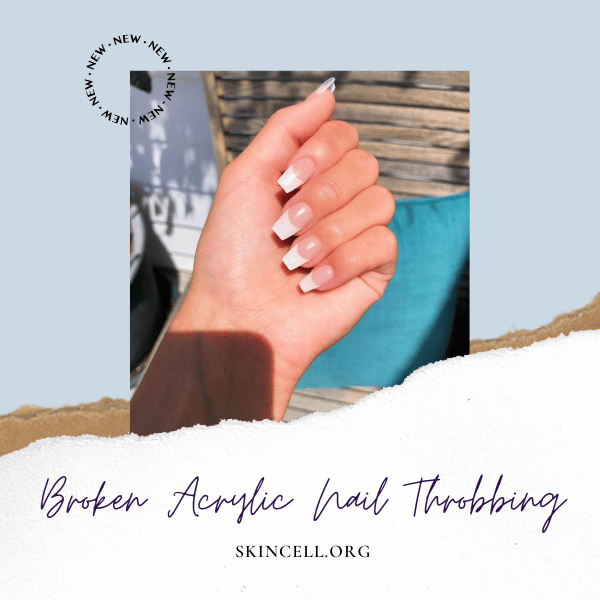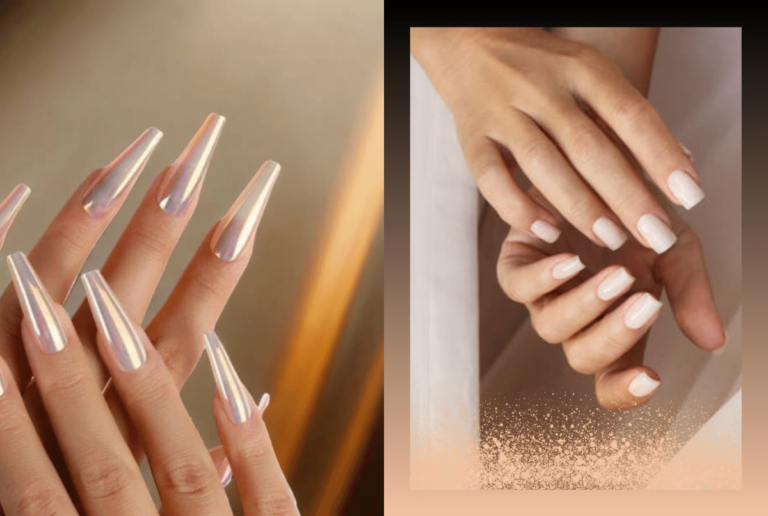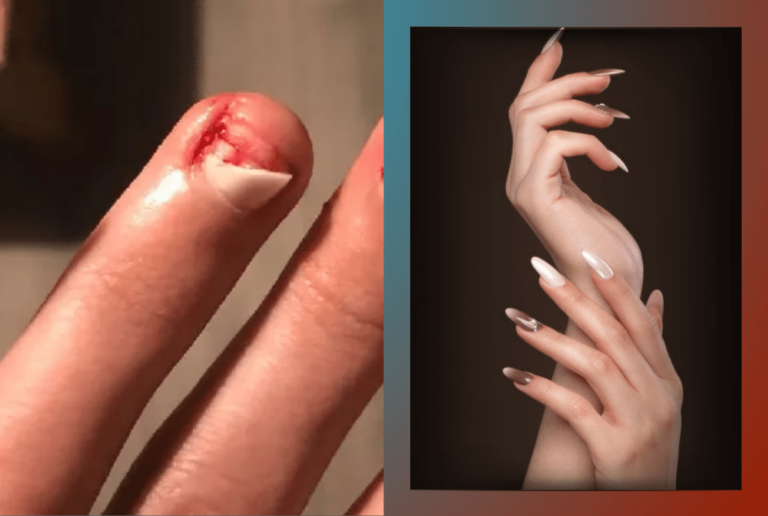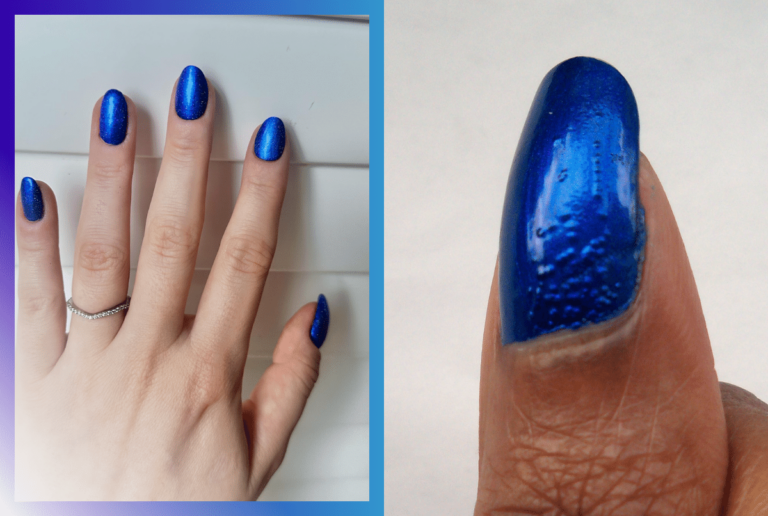Broken Acrylic Nail Throbbing
Experiencing the throbbing pain of a broken acrylic nail?
You’re not alone. This common issue among acrylic nail enthusiasts can be more than just a minor inconvenience. When an acrylic nail breaks, it can cause significant discomfort and even lead to damage to your natural nail bed.
But don’t worry, there are effective ways to manage the pain and ensure proper healing.
Well, we’ll be going over:
- Why do acrylic nails sometimes cause throbbing pain when they break?
- What immediate steps should you take to alleviate pain and prevent further damage?
- How can you ensure long-term care for your nails post-injury to prevent future breaks?
Let’s dive in

Understanding Acrylic Nail Injuries
If you have ever experienced a broken acrylic nail, you know how painful it can be. In some cases, the pain can be so intense that it throbs constantly.
Understanding the causes of broken acrylic nails and how to identify a throbbing acrylic nail can help you prevent further injury and manage the pain.
Causes of Broken Acrylic Nails
There are several causes of broken acrylic nails, including trauma, improper application, and natural wear and tear. Trauma to the nail can occur from hitting it against a hard surface or from excessive pressure, such as when opening a can or bottle.
Improper application of the acrylic nail can also cause it to break, as can natural wear and tear from everyday activities.
In some cases, a broken acrylic nail can also lead to a nail bed injury. The nail bed is the skin underneath the nail, and it can become injured if the nail breaks off too close to the skin. This can cause pain, swelling, and even infection.
Identifying a Throbbing Acrylic Nail
If you have a broken acrylic nail that is throbbing with pain, it is important to identify the cause of the pain. Throbbing pain can be a sign of an infection or injury to the nail bed.
Look for signs of redness, swelling, or discharge around the nail. If you notice any of these symptoms, seek medical attention immediately.
In some cases, the throbbing pain may be caused by pressure on the nail. If this is the case, you can try relieving the pressure by gently filing down the broken edge of the nail or applying a small amount of pressure to the nail to push it away from the skin.
Overall, understanding the causes of broken acrylic nails and how to identify a throbbing acrylic nail can help you prevent further injury and manage the pain. If you are experiencing severe or persistent pain, or if you notice any signs of infection, seek medical attention right away.
Immediate Actions and First Aid
If you have broken your acrylic nail and are experiencing throbbing pain, you need to take immediate action to reduce swelling and protect the damaged nail bed. Here are some steps you can take to alleviate the pain and prevent further injury.
Reducing Throbbing and Swelling
- Ice the affected area: Applying ice to the injured nail bed can help reduce swelling and alleviate pain. Wrap the ice in a towel or cloth and apply it to the affected area for 15-20 minutes at a time, several times a day.
- Elevate your hand: Keeping your hand elevated above your heart can also help reduce swelling and throbbing. This will help the blood flow away from the injured area.
- Take pain relievers: Over-the-counter pain relievers such as ibuprofen or acetaminophen can help alleviate pain and reduce swelling.
Protecting the Damaged Nail
- Bandage the nail: Covering the damaged nail with a sterile bandage can help protect it from further injury. Make sure to change the bandage regularly to prevent infection.
- Avoid putting pressure on the nail: Try to avoid using the affected hand as much as possible. Putting pressure on the damaged nail can cause further pain and injury.
- Protect the nail with a splint: If the nail is severely damaged, you may need to protect it with a splint. This will help prevent further injury and allow the nail to heal properly.
Remember, if the pain and swelling do not improve or if you notice any signs of infection such as redness or discharge, seek medical attention immediately. Taking quick and appropriate action can help you recover faster and prevent further complications.
Professional Nail Care and Repair
If you wear artificial nails, you may have experienced the discomfort of a broken acrylic nail. The throbbing pain can be distracting and make it difficult to perform everyday tasks. Fortunately, there are techniques that a nail technician can use to repair your broken nail and alleviate the pain.
When to See a Nail Technician
If you have a broken acrylic nail that is causing you pain, it is important to see a nail technician as soon as possible. Delaying treatment can lead to further damage or infection. A nail technician can assess the damage and determine the best course of action to repair your nail.
Repair Techniques for Broken Acrylics
There are several techniques that a nail technician can use to repair a broken acrylic nail. One common method is to use nail glue to salvage the broken piece and fill in any gaps.
The technician will apply the glue to the broken edges of the nail and carefully press the broken piece back into place. Once the glue has dried, the technician will file and shape the nail to restore its natural appearance.
Another option is to apply a new acrylic overlay to the entire nail. This technique is often used if the nail is severely damaged or if the broken piece cannot be salvaged.
The technician will remove the damaged acrylic and apply a new layer of acrylic to the entire nail. This process is known as a fill and will restore the nail to its original length and shape.
In conclusion, if you experience a broken acrylic nail, it is important to seek the help of a nail technician. They can assess the damage and determine the best course of action to repair your nail.
Whether it is salvaging the broken piece or applying a new acrylic overlay, a nail technician has the knowledge and tools to alleviate your pain and restore your nail to its natural beauty.
Preventing Infections and Complications
If you have a broken acrylic nail that is throbbing, it is important to take steps to prevent infections and complications. Here are some tips to help you avoid potential problems:
Disinfection and Cleaning
The first step in preventing infections is to disinfect the affected area. You can do this by washing your hands with soap and warm water. You should also clean the broken nail with a disinfectant solution. This will help kill any bacteria or fungus that may be present.
If you notice any signs of infection, such as redness, swelling, or pus, you should seek medical attention immediately. Your doctor may recommend an antibiotic ointment or other treatment to help prevent the infection from spreading.
Signs of Infection and Seeking Medical Attention
It’s important to be aware of the signs of infection so that you can seek medical attention if necessary. Some common signs of infection include:
- Redness or swelling around the affected area
- Pain or tenderness
- Pus or other discharge
- Fever or chills
If you notice any of these symptoms, you should see a doctor right away. In some cases, an infection can lead to more serious complications, such as a fungal infection or even sepsis.
By taking steps to prevent infections and seeking medical attention when necessary, you can help ensure that your broken acrylic nail heals properly and without complications.
Long-Term Nail Health and Maintenance
Maintaining long-term nail health is essential, especially if you frequently apply acrylic nails. Broken acrylic nails can cause throbbing pain and weaken your natural nails. Here are some tips to help you keep your nails healthy:
Strengthening Natural Nails
Strengthening your natural nails is crucial to maintaining long-term nail health. Here are some tips to help you:
- Keep your nails dry and clean to prevent fungal infections.
- Use a moisturizer to avoid brittle nails.
- Take biotin supplements to promote nail growth.
- Avoid using harsh chemicals on your nails, such as acetone and nail polish remover.
- Use a nail strengthener to keep your nails strong.
Proper Removal and Aftercare
Proper removal and aftercare are essential to maintain long-term nail health. Here are some tips to help you:
- Avoid peeling off acrylic nails as it can damage your natural nails.
- Soak your nails in acetone to dissolve the acrylic nails gently.
- Use a cuticle oil to moisturize the nail bed and cuticle.
- Avoid applying nail polish on your natural nails immediately after removing acrylic nails.
- Give your nails a break from acrylic nails to allow them to breathe and grow.
By following these tips, you can maintain long-term nail health and avoid broken acrylic nail throbbing. Remember to take care of your nails, and they will look great for years to come.
Frequently Asked Questions
What is the best method to treat a nail that has broken under an acrylic?
If your nail has broken under an acrylic, the best method is to remove the acrylic nail as soon as possible. Leaving the broken nail under the acrylic can cause further damage and pain.
You can remove the acrylic nail by soaking it in warm, soapy water for 10-15 minutes, and then gently using a cuticle pusher to lift the acrylic nail from your natural nail. Be sure to avoid using any force, as this can cause additional pain and damage.
What are the steps to remove a painful acrylic nail without using acetone?
If you have a painful acrylic nail that you need to remove but don’t want to use acetone, there are a few steps you can follow. First, you can try soaking your nails in warm, soapy water for 10-15 minutes to help soften the acrylic.
Then, use a cuticle pusher to gently lift the acrylic nail from your natural nail. If the acrylic nail is still difficult to remove, you can try using a nail clipper to carefully clip away as much of the acrylic as possible, being careful not to cut your natural nail.
Repeat the soaking and clipping process until the acrylic nail is completely removed.
How can you stop bleeding from a nail broken beneath an acrylic?
If you experience bleeding from a nail broken beneath an acrylic, the first step is to apply pressure to the area with a clean cloth or tissue. Elevate your hand above your heart to help slow the bleeding. If the bleeding doesn’t stop within 10-15 minutes, seek medical attention.
Once the bleeding has stopped, you can clean the area with soap and water and apply an antibiotic ointment to help prevent infection.
What’s the safest way to remove a broken and painful acrylic nail?
The safest way to remove a broken and painful acrylic nail is to visit a professional nail technician or a doctor. They can safely remove the acrylic nail and provide treatment for any damage or pain to your natural nail.
If you choose to remove the acrylic nail yourself, be sure to follow the steps carefully and avoid using excessive force or cutting your natural nail.
How can I alleviate the throbbing pain after an acrylic nail injury?
To alleviate throbbing pain after an acrylic nail injury, you can apply a cold compress to the affected area for 10-15 minutes at a time. This can help reduce swelling and numb the area to alleviate pain. You can also take over-the-counter pain medication such as ibuprofen or acetaminophen as directed.
What could be causing a throbbing sensation after getting acrylic nails?
A throbbing sensation after getting acrylic nails could be caused by a number of factors, including damaged or broken nails, improper application of the acrylic, or an allergic reaction to the acrylic material.
If you experience throbbing or pain after getting acrylic nails, it’s best to visit a professional nail technician or a doctor to determine the cause and receive appropriate treatment.






